- Bernard Preston homepage
- Beekeeping
- Basic Mead Equipment
Basic mead equipment
This is the minimum basic mead equipment necessary to brew your own homemade honey-wine. Below you'll find a list of exactly what you will need.
The first requirement of course is good natural honey. It is one of the three most adulterated foods in the world so this is not a given fact; the other two are dairy products and olive oil by the way.
Naturally we recommend you keep your own bees and use the gleanings from the cappings for making mead.
How to start beekeeping is something for everyone to consider; remember they sting when molested.
Carboy
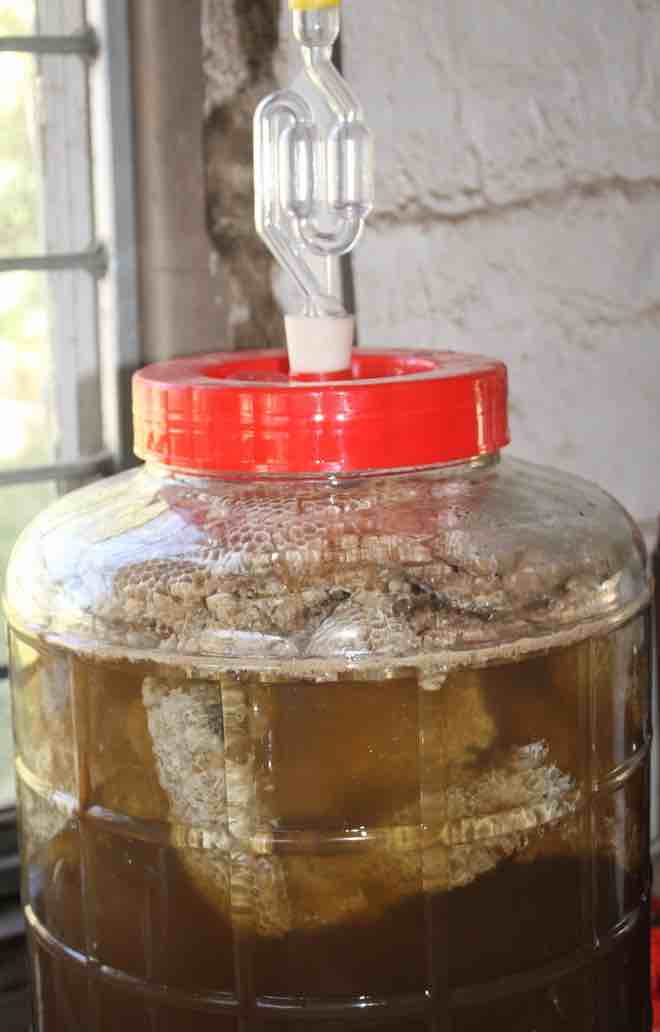
First and foremost you need to purchase an eight or 23 litre glass carboy; or better still both. They are expensive and fragile, so getting them couriered can be difficult.
One can use plastic but if you are serious about making mead start properly with glass. It must have an air-lock.
Cared for properly it should last for years. Be aware that a 23 litre carboy like that above, filled with liquid, is very heavy; it's best filled in situ rather than moved.
Demijohns
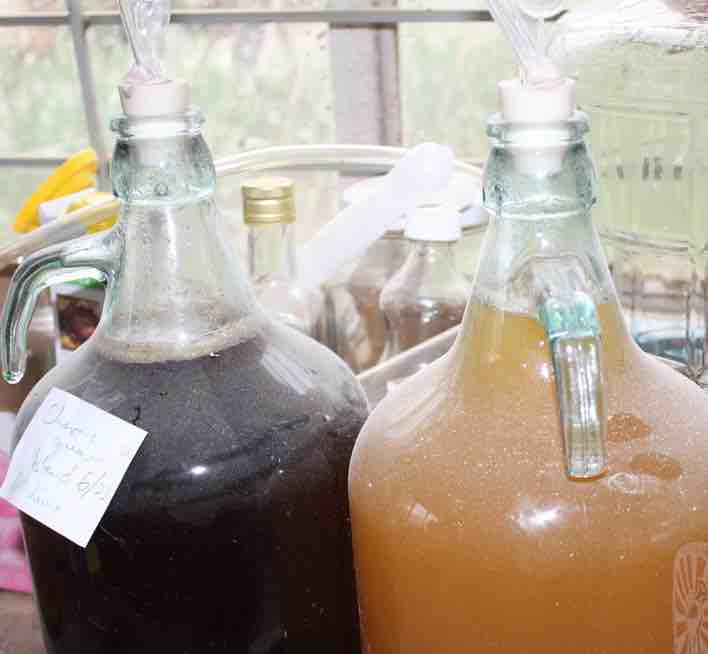
4.5 litre demijohns are the standard when purchasing basic mead equipment.
Since you won't be bottling for about six months at least, I recommend you purchase at least four of these if you are going to take this seriously. This is particularly true if you plan to sell your mead when it is a year or two old.
Sediment will slowly settle at the bottom as the mead clears; you'll need a fifth demijohn into which you will rack the liquid.
Those above are two of my favourite melomels, by the way; from cherry-guavas and peppadews.
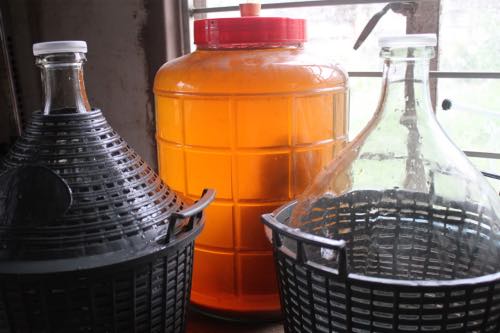 23L carboy of peppadew mead with two 10 litre demijohns
23L carboy of peppadew mead with two 10 litre demijohnsHaving different sizes of demijohns is useful; so they will take most of the mead in the carboy. These 10 litre beauties are a welcome addition to the mix. Costing over R500 each they come in a protective basket.
Hydrometer, test jar and thermometer
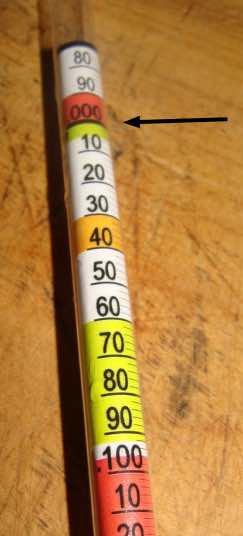
Whilst you can get away with not having a hydrometer it is the only way to be sure that fermentation has ceased; and to measure the alcohol concentration. It must read at least from 0.990 to 1.160.
Since we tend not to bottle for at least six months, fermentation should be complete; mead is strange stuff though and sometimes it will start bubbling again. Should a container burst the flying fragments of glass-shards will be very dangerous.
You will need a narrow test jar at least 250ml long for the hydrometer; it doesn't have to be graduated.
Temperature control is important; you need a kitchen thermometer.
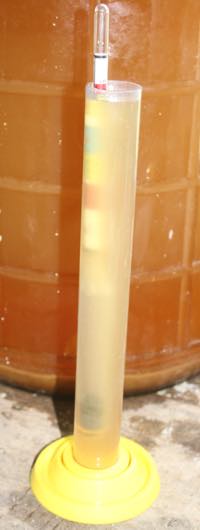 Hydrometer and test jar
Hydrometer and test jarThe final specific gravity (FG) of this peppadew mead is 1.000. Fermentation is complete after 9 months; the liquid is murky as I've just removed the bag of fruit and added bicarb to adjust the pH. Some of the sediment has been stirred up. Several months need to pass now before racking.
"I now find myself wishing I’d focused less on the extreme sanitization, strict temperature parameters and other regimented guidelines espoused by homebrewing manuals."
- Jereme Zimmerman author of Make Mead like a Viking
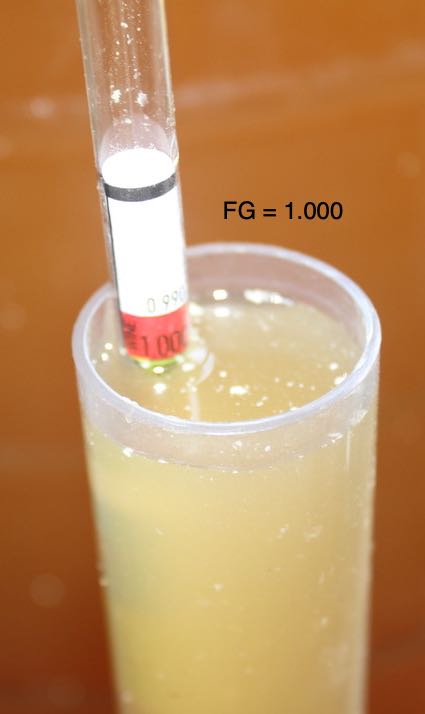
Auto-syphon
An auto-syphon enables you to rack off the clear liquid without disturbing the sediment at the bottom. In theory you could just have a tube but it's messy and you are likely to get contamination.
I did not have an auto-syphon initially and now would not go without. I consider it one of the essentials in our list of basic mead equipment.
The rubber washer tends to dry out; soak in water for an hour before use or you may get air being sucked into the tube; that increases the risk of aerobic bacteria and vinegar.
Mead thief
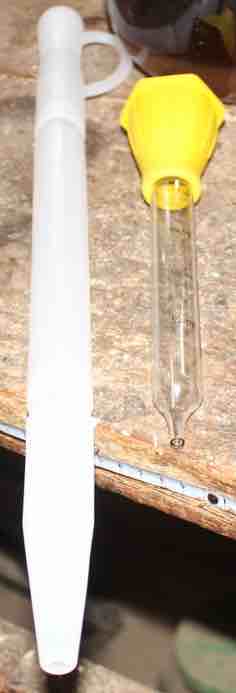
A turkey-baster is commonly used for a mead thief. It's useful having two; one long and the other short and narrow so that they can be inserted into the demijohns.
It's used for removing a small sample of mead for tasting and measuring the specific gravity. Occasionally you may overfill the carboy; then your wine thief is invaluable for removing some of the liquid.
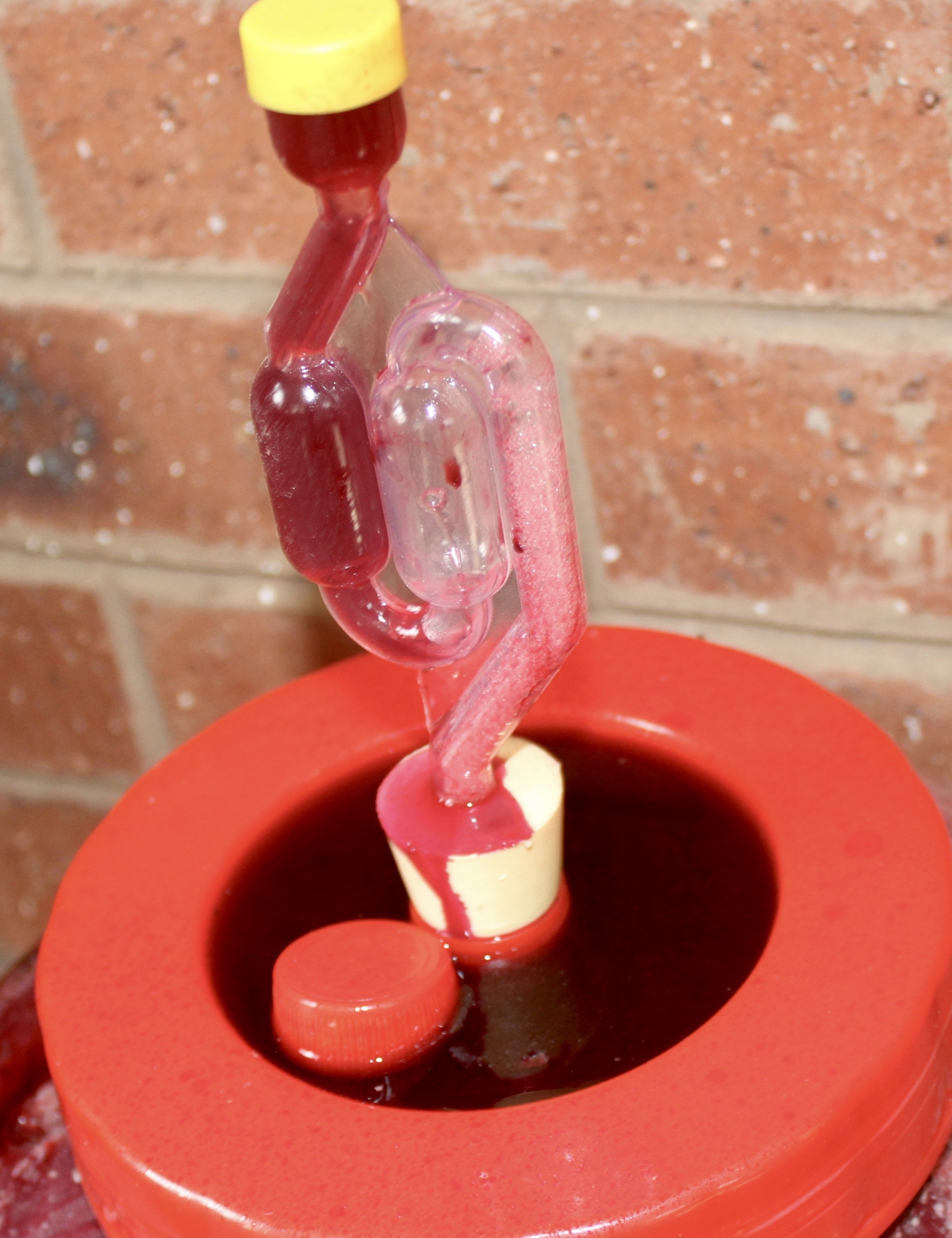
Ph testing strips
Testing strips for measuring the pH of your mead are essential; getting fermentation started quickly is very dependent on the acidity. And a mellow-tasting melomel can be spoiled if the alkalinity isn't just right.
In South Africa these pH testing strips can be bought from Distillique, Glass World and Clicks pharmacy.
Since I am colour blind, I thought to purchase a pH meter; this one proved hopeless. It failed before being used successfully even once; the manual that came with it was unsatisfactory, not naming the batteries required nor the polarity.
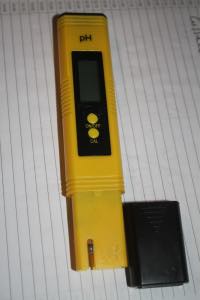
Assorted spoons, funnels and a bottle-washer
Some of the basic mead equipment will be standard in every kitchen. Being able to get your bottles absolutely clean is imperative.
Sterilising liquid or powder too is important; a quality mead is all about keeping foreign bugs out.
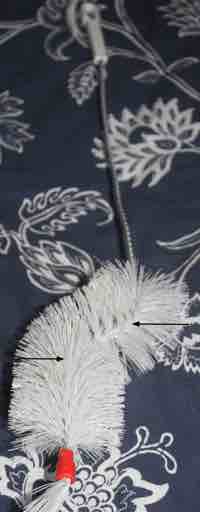
Dirt tends to bond onto the glass of the carboy at the curve and can be difficult to remove. Bending a standard bottle brush 3cm below where the bristles start and again half way down may help. Swishing a handful of grit and a few cups of water about would work too.
Honey, rainwater and yeast
You cannot make a decent mead without good quality honey; the less processed the better. For this reason we like using the gleanings; you will also get pollen from the cappings that acts as a yeast nutrient.
We use only completely unheated honey; all of those special phytonutrients are retained.
There are a number of wine yeasts available, some which will take your mead up to 18% alcohol. A piece of honeycomb filled with fresh pollen, one inch in diameter, will supply all the nutrients needed.
One can leave chlorinated water overnight on the counter but we prefer to use that from a spring or the rain. Most from the utility these days is contaminated with many compounds that they simply cannot remove; and microplastic particles too.
Dedicated meadery
You know you have arrived when your mead equipment includes a dedicated room; it's definitely not included amongst the basic items.
It's not unimportant. Brewing and baking too are all about cleanliness. Wild yeasts can sometimes produce a unique and special flavour but more often than not they will spoil days of work.
It's far easier to sterilise a dedicated meadery than one like mine; brewing must share its space with beekeeping, a corn flour milling machine and general carpentry.
All-hive meads and melomels
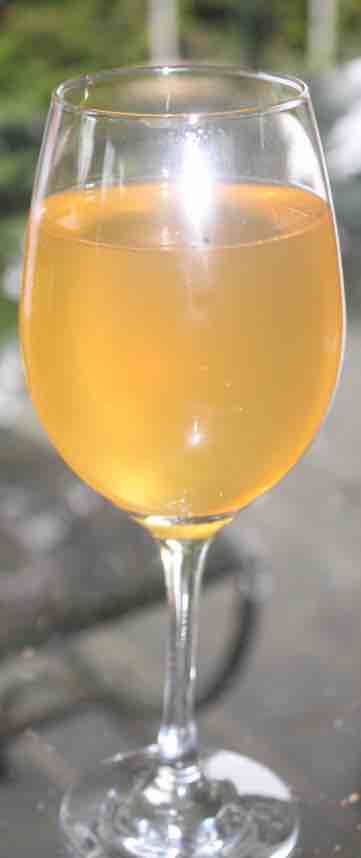
Once you have your basic mead equipment you can start to think about honey-wines and melomels; the latter are made with the addition usually of some fruit.
I particularly love this spicy peppadew mead. It has not yet completely cleared but that is of little concern except to the purist; in fact the yeast cells in suspension act as an excellent probiotic.
It's springtime in South Africa as I write; very soon I will be making a mulberry honey melomel.
Intestinal flora
A happy alimentary canal contains an astonishing 2kg of friendly bugs known as the intestinal flora, or microbiome. So important are the bacteria, yeasts and viruses to our wellness that together they are being described as the Second Brain; another organ.
Virtually all commercial food and drink is pasteurised to kill off these bugs. Your homemade beers, meads and melomels of course are loaded with this friendly flora.
Your basic mead equipment is actually going to improve your well-being provided you know that alcohol makes a very good servant, but an extremely dangerous master. This is a controversial statement; commercial booze is whole different story.
For those interested in the microbiome, how to make kefir is a much simpler way to re-establish the intestinal flora.
Basic mead equipment
Basic mead equipment will enhance your health by providing friendly yeasts for the microbiome but make sure that the alcohol keeps its place as a servant in the home; it's always wanting to become the master.
- Takealot
- Beerguevara
- Brewmart
- Distillique
Total cost
Equipment
- 2 carboys 23L + 8L
- 10 demjohns
- Syphon + pipette
- Glucometer
- pH testing strips
- Bottlebrush
- Plastic containers for sterilising
TOTAL
Cost (in Rands)
- 1,200
- 2,500
- 350
- 200
- 200
- 100
- 120
R4,600
I have currently 8 demijohns maturing, one is active; the value already is in excess of R5,000. Since all the honey comes from the gleanings from cappings there is no direct cost.
It's impossible to measure the value of the improved wellness from a healthier microbiome; or the pleasure and happiness derived from a full life with more than enough to do.
After all the two most dangerous years in a man's life are those when is born and retires.
When browsing use right click and "Open Link in New Tab" or you may get a bad gateway signal.
Newsletter
Our newsletter is entitled "create a cyan zone" at your home, preserving both yourself and Mother Earth for future generations; and the family too, of course. We promise not to spam you with daily emails promoting various products. You may get an occasional nudge to buy one of my books.
Here are the back issues.
- Lifestyle and ideal body weight
- What are ultra-processed foods?
- Investing in long-term health
- Diseases from plastic exposure
- Intensive lifestyle management for obesity has limited value
- A world largely devoid of Parkinson's Disease
- The impact of friendly bacteria in the tum on the prevention of cancer
- There's a hole in the bucket
- Everyone is talking about weight loss drugs
- Pull the sweet tooth
- If you suffer from heartburn plant a susu
- Refined maize meal and stunting
- Should agriculture and industry get priority for water and electricity?
- Nature is calling
- Mill your own flour
- Bake your own sourdough bread
- Microplastics from our water
- Alternative types of water storage
- Wear your clothes out
- Comfort foods
- Create a bee-friendly environment
- Go to bed slightly hungry
- Keep bees
- Blue zone folk are religious
- Reduce plastic waste
- Family is important
- What can go in compost?
- Grow broad beans for longevity
- Harvest and store sunshine
- Blue zone exercise
- Harvest and store your rainwater
- Create a cyan zone at your home
Did you find this page interesting? How about forwarding it to a friendly book or food junkie? Better still, a social media tick would help.
- Bernard Preston homepage
- Beekeeping
- Basic Mead Equipment
Address:
56 Groenekloof Rd,
Hilton, KZN
South Africa
Website:
https://www.bernard-preston.com